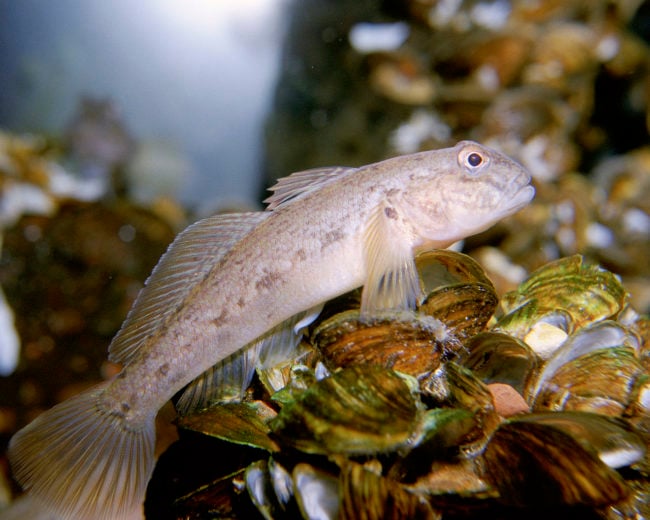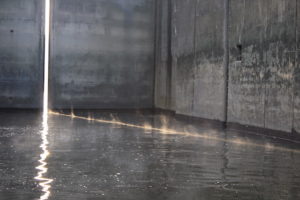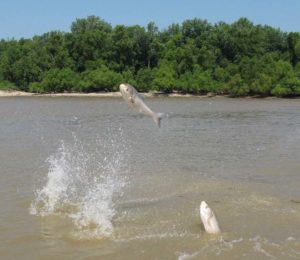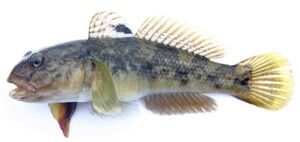Protecting the Hudson from a threat worse than pollution

Round goby. (Photo: USFWS)
View more images on our Flickr site
The round goby, a small fish with frog-like eyes, might not seem like much of a threat. But when the state Department of Environmental Conservation (DEC) captured four of them in the Hudson River in 2021, it set off an alarm.
The DEC found them during routine fish sampling in July, in the upper estuary south of the Troy dam. Since then, more have been captured as far south as Newburgh, as well as into the Upper Hudson River, a stretch of 100 miles. Round goby are now well established and widespread in the Hudson.
We knew this would happen. After being inadvertently introduced to the Great Lakes via ship ballast water in 1990, the round goby colonized all Great Lakes within five years, and from there had entered the Erie Canal by 2013. Its migration through the Erie Canal was monitored by scientists as it made steady progress over seven years from west to east, via the Erie Canal into the Mohawk River, but it was not halted by any government intervention.
Scientists have warned of this threat. Repeatedly. For nearly a decade. It’s time to heed the call.
TAKE ACTION: Ask Gov. Hochul to protect our waters from canal invaders
Engineers have studied how to effectively stop invasive species from spreading through both the Erie Canal and Champlain Canal. Using technology and processes used at many marinas for lifting, washing and winterizing boats, we can close small portions of each canal while maintaining recreational boating access. With careful consultation with the limited commercial users of the canals, we can ensure that industry’s needs are met as well.
Canals were created to connect waterbodies, cutting through the high points that provide natural watershed boundaries that prevent migration of aquatic species. Rarely do we have an opportunity to prevent invasive species problems so effectively as we can by re-establishing “watershed divides” through modern engineering. Preventing invasions often involves complex regulations of industries that might knowingly or unwittingly transport new species via national or international commerce. It involves policing the individual actions of countless boaters, anglers and other outdoors lovers. Once introduced, managing invasive species becomes a game of whack-a-mole, often with each whack involving unpleasant trade-offs. Re-establishing watershed divides, by contrast, offers the rare opportunity to solve an invasive species problem surgically, definitively and proactively. Importantly, they can block a variety of species – not only fish, but plants, molluscs, crustaceans, certain pathogens and other species of concern. (Learn about the species the Hudson River Aquatic Invasive Species Task Force has identified as posing the greatest risk to the Hudson if not effectively prevented from becoming established.)
We need Gov. Kathy Hochul to prioritize the protection of our waters from a threat that is arguably more significant than almost any other type of pollution.
Risks from invasive fish
Round gobies, native to the Black and Caspian sea regions, are voracious feeders, and outcompete native species for food and spawning habitat. Among other things, they eat the eggs of native species and popular sportfish like smallmouth bass and walleye, as well as the eggs of forage fish that many sportsfish rely on, like river herring. It also carries and spreads Viral Hemorrhagic Septicemia (VHS), which has already led to large fish kills in New York State waters.

A lock in the Erie Canal.
The nightmare scenario is that other invasives, like silver carp, grass carp and other invasive carp native to Europe and Asia, now infesting the Mississippi watershed and breaking through to the Great Lakes, are not far behind.
Already half the fish found in the Mohawk River are non-native, and the Hudson River ecosystem has been profoundly altered by multiple invasions, including water chestnut and zebra mussels. (Read about 5 prominent Hudson River invasive species, and what can be done to address them.) The impacts from aquatic invasive species (AIS) are arguably greater than any other pollution source, and longer lasting. Once a species invades, at best it can be managed and contained, but in most cases its effects are permanent. In the case of the Hudson, oxygen-rich shallows where fish spawned and sheltered for thousands of years have been permanently starved of oxygen by water chestnut since its introduction in the 1930s; since 1991 zebra mussels have consumed the food that young-of-year shad and other river herring had relied on, leaving them weaker and less resilient to other stresses, like habitat loss, overfishing and warming waters. The shad population crashed, and with it one of the Hudson’s last commercial fisheries, in 2010. A decade later, American shad have still not recovered, and future invasions via the Erie and Champlain Canals are specifically identified as a risk to their recovery. Other fish populations will collapse, and fishing communities will suffer, if we don’t act. (Read about the status of Hudson River fish.)
A hazard to boaters and anglers

Invasive carp in the Wabash River. Some species can jump as much as 10 feet out of the water, presenting a hazard to boaters. Photo: Todd Davis, U.S. Army Corps of Engineers, CC.
As voracious eaters of plankton, each alone could have profoundly negative impacts on many species that rely on the same food source. In the Illinois River, for instance, invasive carp have come to dominate the ecosystem, with two-thirds or more of all fish biomass accounted for by invasive bighead and silver carp, resulting in significant negative effects on native fish communities. Silver carp can also pose a hazard to boaters, due to their propensity to launch themselves out of the water up to 10 feet in the air.
The failure to take action will have significant consequences; among them: decline in recreational fishing. Notably, recreational striped bass fishing on the Hudson River, which is both a strong cultural force and a major economic contributor to the region, is already at risk. With populations of striped bass declining primarily from stress from recreational fishing alone, state and interstate fisheries managers already have difficult choices to make that are likely to reduce the season for New York’s anglers. Round goby are expected to consume the eggs of river herring, and American, hickory and gizzard shad – all of which are important forage fish for striped bass. If invasive carp reach the Mohawk or Hudson, they will likely grow to dominate the ecosystem, and out-compete these same fish for the plankton they need to survive. Failure to head off threats from stressors like invasive carp will put enormous stress on our already stressed ecosystem. It could lead to further collapse of river herring, and more restrictions for striped bass anglers.
Let’s seize a critical opportunity while we have it.
TAKE ACTION: Ask Gov. Hochul to protect our waters from canal invaders
If you catch a round goby:
• DO NOT return it to the River. Dispose of it ashore, dead.
• Photograph the fish from different angles, record the date and location of capture.
• Email the photos and information to: [email protected]

